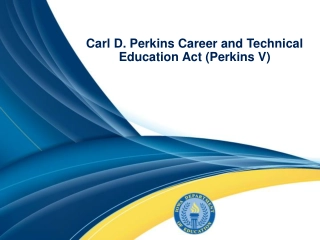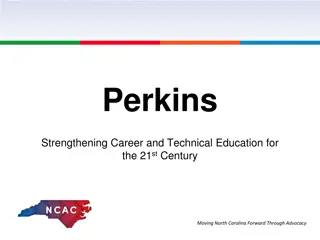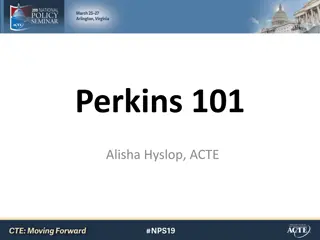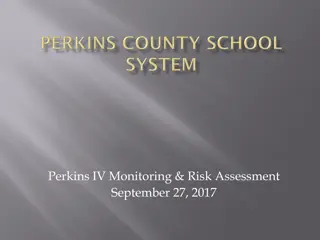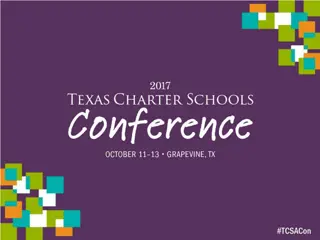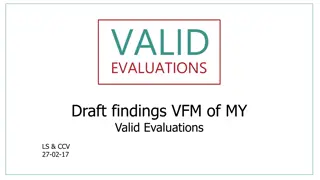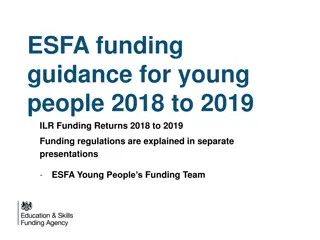Perkins Funding Basics and Highlights
Distribution and allocation details of Career and Technical Education Perkins Funding, including division percentages, usage guidelines, and requirements for administrators and institutions involved in CTE programs.
Download Presentation

Please find below an Image/Link to download the presentation.
The content on the website is provided AS IS for your information and personal use only. It may not be sold, licensed, or shared on other websites without obtaining consent from the author.If you encounter any issues during the download, it is possible that the publisher has removed the file from their server.
You are allowed to download the files provided on this website for personal or commercial use, subject to the condition that they are used lawfully. All files are the property of their respective owners.
The content on the website is provided AS IS for your information and personal use only. It may not be sold, licensed, or shared on other websites without obtaining consent from the author.
E N D
Presentation Transcript
Career and Technical Education Perkins Funding Basics and Highlights!
Distribution of Perkins Funds P. 40 of Delaware CTE 4 year State Plan (Refer here, the following is paraphrased) The total Perkins Grant is broken up into the following percentages. 5% retained by DOE for administrative purposes. 10% retained at DOE for leadership activities. 85% - Reserve Funds (Innovative Grants) and secondary and postsecondary institutions. For a grand total of 100%
How is the 85% divided ? 15% Reserve Funds (Innovative Grants) with 10% to secondary and 5% to postsecondary recipients. Secondary LEAs will use these funds to: 1. Support the expansion of state-model CTE programs of study and middle school college and career readiness coursework; 2. Focus on student equity and achievement for college and careers; and to 3. Develop innovative student supports for college and careers, which can include work-based learning, social-emotional learning, as well as student advisement and counseling services;
How is the 85% divided ? 15% (continued) Postsecondary institutions will use these funds to: 1. Support student credential and degree attainment as well as matriculation into advanced education and training programs and the workforce; and to 2. Develop innovative practices that focus on student equity and achievement.
How is the 85% divided ? The remaining 70% of these funds will be divided between eligible recipients at the secondary level (80%) and postsecondary institutions (20%). The distribution of funds is based on the current percentage of youth and adult learners served across the secondary and postsecondary system (e.g. the current number of CTE participants equals 40,244 students or 30,296 students at the secondary level, i.e. 75% and 9,948 students at the postsecondary level, i.e. 25%) with an additional percentage of funds (5%) designated for student growth at the secondary level to support middle grade expansion. The distribution of funds to eligible secondary (80%) and postsecondary recipients (20%) was determined through meetings with those stakeholder groups defined in the Act and is a result of public comments that prioritized high-quality CTE opportunities for all youth and adult learners.
Requirements As the LEA develops the program budget, the following should be noted: Each LEA shall not use more than 5% of the total amount for administrative costs (direct or indirect) associated with the administration of activities under Perkins;
Recommended Caps It is recommended that no more than 5% of an LEA s grant be allocated for Career and Technical Student Organization (CTSO) expenses. It is recommended that no more than 50% of an LEA s grant be allocated for equipment expenses (with the exception of new equipment). It is recommended that no more than 20% of an LEA s grant be allocated for middle school CTE; ( How can Perkins Funds be used document resource cites 30% for this.)
Recommended Caps It is recommended that no more than 10% of an LEA s grant be allocated for expenses related to travel. It is recommended that no more than 5% of an LEA s grant be allocated for substitute expenses.
Requirements Funds may not be used to supplant available state or local salary sources but may be used to supplement new program initiatives. Administration and indirect costs must total no more than 5%. Additional recommendations/guidance is provided in the CTE Fiscal and Accountability Policy and Procedures.
How Can Perkins Funds Be Used (Chart) Handout (Chart) Strengthening Career and Technical Education for the 21st Century (Perkins V) Allowable and Non-Permissive Uses of Funds Guidance This chart is a great resource and contains Allowable, Allowable with Considerations, and Non-Permissive categories for quick reference.
Group Resource Time Please take this time to discuss the information with the following groups: Your own teaching department. Teachers at other schools in your pathway. Administrators from your school district.
Resources Delaware Department of Education Career and Technical Education- Fiscal and Accountability Policies and Procedures, August 2021. Delaware State Plan Perkins V How Can Perkins Funds Be Used Perkins CGA Guidance All resources are from the Delaware Department of Education website, Spring 2023. For more detailed information please refer to the Delaware Department of Education.


